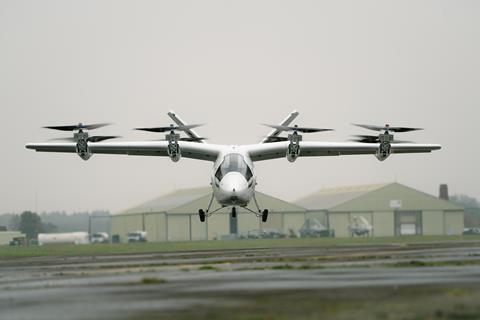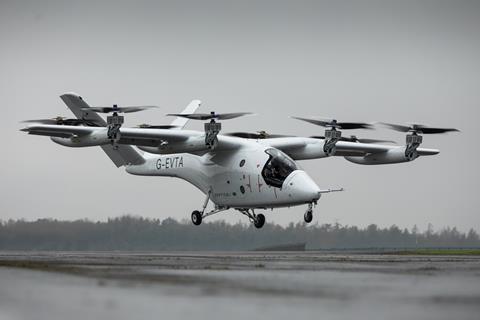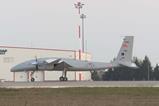Vertical Aerospace’s chief executive says the decision to delay the service entry of its VX4 by two years came after a deep engineering-led review of the electric air taxi’s progress, but he insists there will be no further timeline slippage.
UK-headquartered Vertical on 12 November disclosed the shift, pushing certification and service entry to 2028 from a previous goal of late 2026.

The move is part of a “rebaselining” of the firm’s activities implemented by Stuart Simpson after becoming chief executive in May, stepping up from his previous post as chief financial officer.
Conducted over an “eight- or nine-week period”, the review was led by Vertical’s engineering team and reflects “all the learnings of the last two years”.
“This is what they came up with – 2028 – and they are committed, motivated, the plans are underpinned, detailed and bottom-up and we are ready to go,” he says.
Simpson insists it is “not a marketing-led plan” but is “grounded in the reality that we can and will deliver on this”.
He says customer reaction has been positive, praising Vertical’s “honesty and certainty” despite the delay being a “difficult moment to [raise with] them”.
“There’s a huge obligation to be transparent to the market and our customers,” he says.
Customers will next week witness piloted, untethered flights of the VX4 prototype at the firm’s test centre in Kemble, southwest England, as part of one of its biannual ‘Pioneers’ events. On 12 November, Vertical announced the start of untethered flights – Phase 2 of its test campaign.
While Simpson says “no one single thing” is responsible for the delay, it is clearly in part driven by the first VX4 prototype being written off during a testing mishap in August 2023.
Simpson says that incident – caused by a propeller blade failure – was “deeply frustrating” as Vertical lost an asset “that we wanted to fly and gather engineering learnings from”.
The latest schedule shift is the second delay to the VX4: in 2023 Vertical announced certification had moved from 2025 to 2026.
But Simpson is clear there will be no more slippage to the timeline, adding: “I believe the team can deliver it; I don’t see why we shouldn’t.”
One potential stumbling block though is the absence of a firm financial footing. Vertical, its largest creditor Mudrick Capital, and founder and principal shareholder Stephen Fitzpatrick remain locked in three-way negotiations over a potential cash injection that would fund the business until the end of next year.
To date, no deal has been realised, with Fitzpatrick’s apparent unwillingness to see his stake diluted repeatedly raised as the stumbling block.
However, Simpson says this is far from the truth: “I can categorically state that this is not the case. I had these discussions with Stephen before I joined and he understands in a capital-intensive business… ultimately, unless you want to keep funding millions of dollars, there is a dilution.”
Simpson is unwilling to be drawn on the content of any deal or its likely timing, referring FlightGlobal to Vertical’s official line on the matter: “Discussions are ongoing regarding potential third-party investment. Vertical is optimistic that these discussions will result in a transaction that will provide funding further into 2025 and facilitate future fundraising opportunities.
“In parallel, Vertical continues to explore all alternative options available with respect to its funding needs,” it states.

But Simpson does take a positive sign from the current impasse: the fact that Vertical has two such “emotionally engaged, financially engaged investors” is a “brilliant place to be in”, he says.
Part of his remit since joining as chief executive has been to lay out how Vertical will go about, as he puts it, “pivoting from prototype to production”.
That will see the firm change from one focused on short-term goals to one with longer-term targets, or in other words making the transition from an entrepreneur-led business to “a normal corporate environment”.
While an engaged founder brings “incredible vision and relentless drive”, what Simpson adds is “a little bit of corporate structure and focus and rigour”, not least to address the “significant regulatory challenge [of] certifying a new type of aircraft”.
“I think we all felt – the board, Stephen and me – is that it was the right time to make that pivot and look to the horizon about bringing in production.”
The result of Simpson’s efforts to date was the release on 12 November of Flightpath 2030 – Vertical’s strategy to achieve market leadership before the end of the decade. “I’m incredibly proud of what we put out,” he adds.
Included was the promise that Vertical will deliver the first upgrades to the VX4 in 2030. Although the plan offers strong hints that this will see an increase in capacity from four to six passengers, Simpson says the developer is keeping its options open.
“We haven’t commented precisely what the upgrade is,” he says, noting that the airframer has “several options”.
“What I really want to do is sit with the customers and see how they want to leverage the effort,” he adds.
In the meantime, Vertical continues to analyse where to locate its first factory – one that will be capable by the end of the decade of producing the 200 or more aircraft per year promised in its Flightpath 2030 plan.
Simpson says no decision has been taken beyond the fact that “we want to be based in the UK”, with its current home of southwest England “a very likely candidate”.
Six months in, Simpson is still relishing the role, despite, or perhaps because of the challenges involved.
“I get approached about roles all the time…but honestly I can’t think of a job I would rather do more,” he says.































